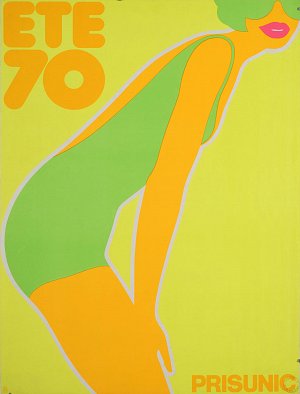
Friedemann Hauss, Prisunic Summer 70 Poster, 1970
Paper, Silkscreen
© MAD, Paris / Christophe Dellière
Founded in 1931 the Prisunic department
store followed an American style
of marketing introduced in France in 1946
under the leadership of its new Director,
Jacques Gueden, who in the 1950s,
endeavoured to provide contemporary,
quality furniture and fashion at affordable
prices. “Beauty at the price of ugly”
became the brand’s official slogan
under the leadership of Denise Fayolle,
Director of the Style Office from 1957
to 1967. Prisunic initiated many important
collaborations with top designers of the
day. Terence Conran participated in the
design of the first catalog in 1968,
a catalog that skillfully staged furniture,
lighting and tableware for a new audience
of mail-order consumers. Driven by their
shared interest in keeping high style
design accessible to all, Prisunic and
Monoprix merged in 1997, reaffirming their
commitment to keeping “the pleasure
of living in the French way” alive for
their customers.
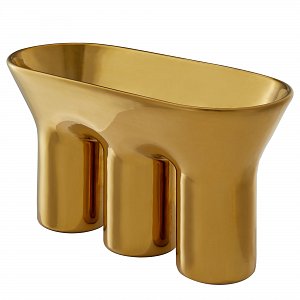
Ionna Vautrin, Vase 2021
Ceramic
© Eugénia Sierko / Monoprix
Le design pour tous : de Prisunic à Monoprix, une aventure française is a thematic and
chronological exhibition presented in two
segments. The first, devoted to Prisunic,
will underline the major collaborations
that existed with designers and graphic
designers who heralded in the age of mailorder
catalogues between 1968 and 1976.
The second will focus on the creations
of the designers invited by Monoprix,
showcasing the daily object, tables,
seats and clothing, a theme at the heart
of the brand.
Presented in the Modern and
Contemporary Galleries of the Musée
des Arts Décoratifs, the exhibition’s
route follows a “ready-made” process
(furniture and store displays used in the
presentation of objects) that evokes the
world of mass distribution through a bright
and colourful scenography.
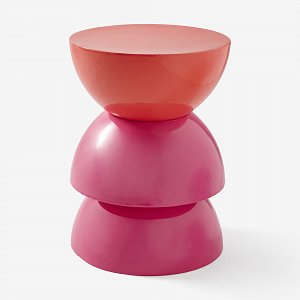
India Mahdavi, Piccolo stool, XMAS Summer Collection, 2017
Lacquered Metal
© Eugénia Sierko / Monoprix © Adagp, Paris, 2021
On Level Three, the visit begins with
emblematic designs by Monoprix stylised
in gold finish shown through repurposed
refrigerators and signed by Marion
Lesage, India Mahdavi or Ionna Vautrin.
Advertising films and filmed interviews
animate the space. The following spaces
are converted into period rooms, both
by Prisunic, showcasing a period bedroom
and living room with simple, accessible,
and functional furniture in coloured metal
or polyester. Some pieces, such as the
molded polyester bed designed by Marc
Held in 1970 and the enameled sheet
metal furniture created by visual artist
Jacques Tissinier in 1973, are held in the
permanent collections of the Musée
des Arts Décoratifs and have become
1970s-design icons.
On Level Five of the Pavillon de Marsan,
Design for All sheds light on the history
of each brand, unveiling rare archival
documents and “merchandising” items
such as shopping bags, brand pins,
advertising key chains, market trolleys
on original cash registers used in stores.
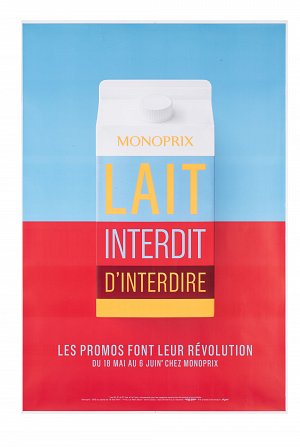
Rosapark Agency, poster Lait interdit d’interdire, 2018
Paper, Offset
© MAD, Paris / Jean Tholance
Works from the vast collection of posters
and advertising art of the Musée des
Arts Décoratifs will be on display in the
“News Gallery” segment of the exhibition,
with important works commissioned
by Prisunic and Monoprix from some
of France’s most prominent advertising
agencies and graphic designers. These
include graphic designs by Friedemann
Hauss, Roman Cieslewicz for MAFIA
(Maïmé, Arnodin, Fayolle, International
Associés), but also works by advertisers
such as T.B.W.A (Tragos, Bonnange,
Wiesendanger, Ajroldi), and R.S.C.G
(Roux, Seguéla, Cayzac, Goudard), who
developed the true visual identity of
Prisunic. More recent involvement has
come from the FCB Agency (Denis Garcia
Garcia & Lily Van der Stokker), which
collaborates frequently with Monoprix, and
Cléo Charuet from the Havas City Agency,
which became Rosapark, reviving the
brand’s identity with its capital letters and
band of colours. In 2021, and in reaction
to the different lockdowns, Monoprix
began working with the DDB agency
to fulfill its advertising needs.
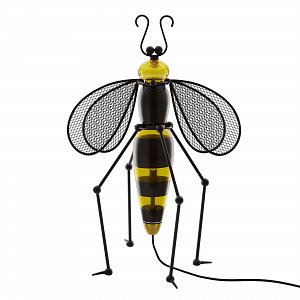
Vincent Darré, Bee Lamp, 2021
Glass, Metal
© Eugénia Sierko / Monoprix
The second segment of the exhibition
on Level Five looks back at the
collaborations forged over the last two
decades. Through a prism of dream
and fantasy, this segment will present
elaborate creations, such as a wedding
dress by Couturier Alexis Mabille,
complimented by a wall covered
in decorative plates signed G by Gien and
others by Antoinette Poisson, giving life
to ancestral techniques of craftsmanship.
The route is punctuated by a period room
dedicated to objects designed for daily
activities such as dining, going out and
dressing. It also showcases monographs
by Maison Château Rouge, whose
2018 collection celebrated the works
of the Indian women’s social enterprise
Creative Handicrafts.
The Marsan Pavillon also hosts
monographs by some of Monoprix’s most
emblematic designers, including India
Mahdavi, Paola Navone, Ionna Vautrin,
Constance Guisset and Nadia Gallardo.
Artisanal designs from India and
Africa also mingle with the permanent
collections, evoking the international
scene. In this room, visitors are brought
back to their childhood, an important field
of exploration for designers, illustrated
by children’s clothes and toys from the
permanent collections of the Musée des
Arts Décoratifs.
Dialoguing with major achievements
of design icons, the Little Black Dresses
by Alexis Mabille, Hussein Chalayan, Yiqing
Yin, Anne Valérie Hash and Giles Deacon
(2013) dress up Jean Prouvé’s bedroom
for the Cité Universitaire d’Antony, while
Le Corbusier’s kitchen, based on a project
by Charlotte Perriand for the Cité Radieuse
in Marseille, is filled with everyday objects
and utensils.

Hussein Chalayan, Giles Deacon, Anne Valérie Hash, Alexis Mabille, Yiqing Yin, Little Black Dresses, 2013
Textile
© Monoprix
The exhibition route comes to a close
in the Library of the Musée des Arts
Décoratifs, where every issue of the
Prisunic catalogues that marked
generations, supplemented by lithographs
sold at the behest of Jacques Putman
between 1967 and 1973, are here
displayed. This final segment questions
the notion of colour – a true chromatic
manifest of the two brands –
in conjunction with the collections
of the Library.
With Le design pour tous : de Prisunic à Monoprix, une aventure française, the
Musée des Arts Décoratifs will hold its
first-ever exhibition dedicated to the
world of mass distribution, which
marked the fate of creative adventure
in France. This exhibition will bring a new
perspective to many of the objects held
in the permanent collections of the
Musée des Arts Décoratifs, which already
presented, since 2018, a selection
of Prisunic pieces from the museum’s
collections.